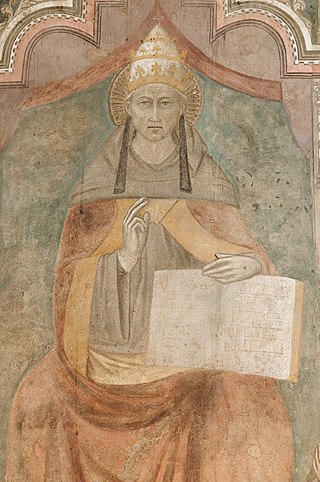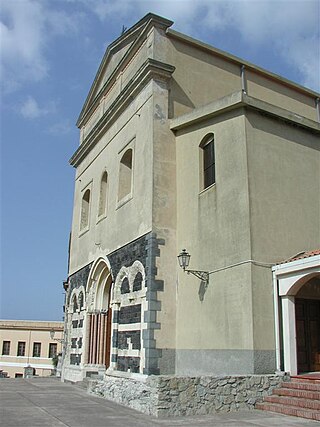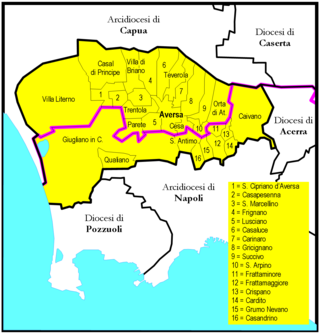
Pope Celestine V, born Pietro Angelerio, also known as Pietro da Morrone, Peter of Morrone, and Peter Celestine, was head of the Catholic Church and ruler of the Papal States for five months from 5 July to 13 December 1294, when he resigned. He was also a monk and hermit who founded the order of the Celestines as a branch of the Benedictine order.

The Diocese of Nola is a Latin diocese of the Catholic Church in Italy, suffragan of the Archdiocese of Naples. Its seat is the Campanian city of Nola, now a suburb of Naples. Its cathedral is dedicated to the Assumption. The dedication was originally to S. Stephen, the Protomartyr, but after the second reconstruction the dedication was changed to the Assumption. It is traditionally credited with the introduction of the use of bells into Christian worship.

The Archdiocese of Capua is a Latin diocese of the Catholic Church in Capua, in Campania, Italy, but its archbishop no longer holds metropolitan rank and has no ecclesiastical province. Since 1979, it is a suffragan of the Archdiocese of Napoli, i.e. no longer has its own ecclesiastical province nor metropolitan status.

William de Lamberton, sometimes modernized as William Lamberton, was Bishop of St Andrews from 1297 until his death. Lamberton is renowned for his influential role during the Scottish Wars of Independence. He campaigned for the national cause under William Wallace and later Robert the Bruce. As Bishop of St Andrews, the most powerful seat in Scotland, Bishop Lamberton along with Bishop Robert Wishart of Glasgow conducted the coronation of Robert the Bruce as King Robert I. Lamberton would go on to have a vital role in the formulation of the Declaration of the Clergy 1310 and the Declaration of Arbroath which would lead to Scottish Independence.

The Diocese of Patti is a Latin diocese of the Catholic Church located on the north shore of the island of Sicily. It is a suffragan of the Archdiocese of Messina-Lipari-Santa Lucia del Mela. Its patron saint is Bartholomew the Apostle, in whose honor the cathedral is named.

The Archdiocese of Amalfi-Cava de' Tirreni is an archdiocese of the Latin Church of the Catholic Church, with its episcopal see at Amalfi, not far from Naples. It was named Archdiocese of Amalfi until parts of the Diocese of Cava e Sarno were merged with it on September 30, 1986.

The Diocese of Aversa is a Latin diocese of the Catholic Church in Campania, southern Italy, created in 1053. It is situated in the Terra di Lavoro (Liburia), seven miles north of Naples, and eight miles south of Capua. It is suffragan of the Archdiocese of Naples.

The Roman Catholic diocese of Ferentino existed until 1986, when it was united into the new diocese of Frosinone-Veroli-Ferentino.

The diocese of Cagli e Pergola was a Roman Catholic ecclesiastical territory in the Marche, central Italy, in the province of Pesaro and Urbino. Up until 1563 it was under the direct supervision of the Roman pontiff. In that year, the diocese of Urbino was elevated to metropolitan status, and Cagli became a suffragan see of Urbino. The diocese was abolished as an independent entity in 1986, when it was incorporated into the diocese of Fano-Fossombrone-Cagli-Pergola. It was still a suffragan of the archdiocese of Urbino.

The Diocese of Rieti is a Latin Church ecclesiastical territory or diocese of the Catholic Church in Italy. It is immediately exempt to the Holy See. Its cathedra is in St. Mary Cathedral in the episcopal see of Rieti.

The Diocese of Padua is a Latin diocese of the Catholic Church in Veneto, northern Italy. It was erected in the 3rd century. The diocese of Padua was originally a suffragan (subordinate) of the Patriarchate of Aquileia. When the Patriarchate was suppressed permanently in 1752, it became a suffragan of the Archdiocese of Udine. In 1818, when the dioceses of northern Italy were reorganized by Pope Pius VII, it became a suffragan of the Patriarchate of Venice, and remains so today.
Giovanni Boccamazza was an Italian Cardinal. He was from the Roman nobility, and was a nephew of Cardinal Giacomo Savelli, who had been an important figure in the Roman Curia since his creation as cardinal in 1261.

The Archdiocese of Chieti-Vasto is a Latin Church diocese of the Catholic Church which received that name in 1986, when the two separate dioceses, which had been governed by one and the same bishop, were united in one diocese. The diocese of Chieti had become the Archdiocese of Chieti in 1526, when promoted by Pope Clement VII. Chieti is about 8 miles (14 km) south-west of the Adriatic port city of Pescara.

The Diocese of Chioggia is a Latin diocese of the Catholic Church in the Veneto, at the southernmost point of the Laguna veneta. Until 1451, the diocese was a suffragan of the Patriarchate of Grado. On 8 October 1451, in the bull "Regis Aeterni", Pope Nicholas V abolished the patriarchate of Grado, and transferred its powers and privileges to the Archdiocese of Venice. Since then, Chioggia has been a suffragan of Venice.

The Archdiocese of Monreale is a Latin archdiocese of the Catholic Church in Sicily. As of 2000 it is no longer a metropolitan see, and is now a suffragan of the Archdiocese of Palermo.

Gerardo Bianchi was an Italian churchman and papal diplomat, an important figure of the War of the Sicilian Vespers.

Jean Lemoine, Jean Le Moine, Johannes Monachus was a French canon lawyer, Cardinal, bishop of Arras and papal legate. He served Boniface VIII as representative to Philip IV of France, and founded the Collège du Cardinal Lemoine, in Paris. He is the first canon lawyer to formulate the legal principle of the presumption of innocence.

The Roman Catholic Diocese of Lipari was a Latin diocese of the Roman Catholic Church located in the town of Lipari in the Aeolian Islands of Sicily, Italy. The diocese consists of the entire island of Lipari as well as seven smaller adjacent islands. It is now incorporated into the Archdiocese of Messina-Lipari-Santa Lucia del Mela.
Nicolas de Nonancourt. He was a French university Chancellor, Dean of a Cathedral, and Roman Catholic Cardinal.
Pietro Correr was an Italian Roman Catholic clergyman of the Correr family of Venice.
















